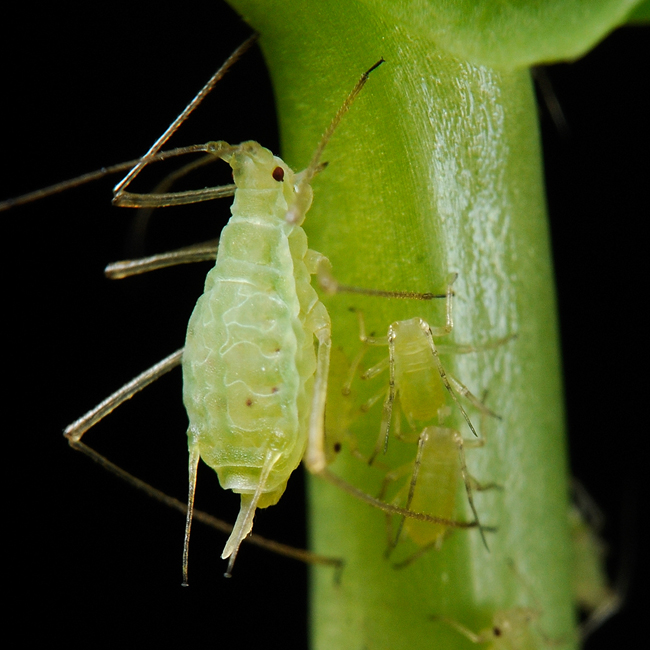
Category: Aphids
MORE INFORMATION:
Wikipedia
iNaturalist
PNW Pest Management Handbook
The Legume Virus Project
Pea aphid (Acyrthosiphon pisum)
Biology and life history: Pea aphid is a global pest of leguminous crops and weeds, causing direct injury and vectoring plant viruses such as Pea enation mosaic virus, Bean leafroll virus, Alfalfa mosaic virus, and Pea streak virus. The common biotype found in the Palouse region is large, green with long legs, antennae, and cornicles (tail-like structure coming from the rear abdomen). The life cycle is similar to most other aphids, with females giving birth to live offspring all season; after overwintering, they come out in spring and start feeding on crops.
Host plants and crop damage: Pea aphid attacks peas, alfalfa, lentil, and others, but when the crop host is not available, they also live on various leguminous weeds. Pea aphid colonizes and feeds primarily on young stems and leaves. The aphids injure the crop by sucking plant saps. If aphids are in very high density (~50 aphids/stem), they can damage, wilt, or kill the host plant. In addition to the direct injury caused by feeding, pea aphids transmit legume viruses that damage the plant.
Management: Although relatively rare in the Palouse region in the past decades, pea aphid outbreak years may require aggressive management to prevent direct injury and disease transmissions. Except during the outbreak years, prophylactic seed treatments or insecticide sprays for pea aphids are usually unnecessary.
Natural enemies such as lady beetles, green lacewings, big-eyed bugs, damsel bugs, syrphid fly larvae, or parasitoid wasps provide good controls of pea aphids, but these beneficial insects can be killed due to insecticide spray for pea weevil, pea leaf weevil, or other pests. When there is a high density of aphids and if natural enemies fail to keep them in check, safe application of certain insecticides (e.g., Neemix 4.5, PyGanic, Mycotrol O, alpha-cypermethrin) help minimize the yield loss.
To provide decision supports to growers with seasonal monitoring of pea aphid and viruses in the Palouse region, The Legume Virus Project was established in 2007. Aphids are monitored with a network of field-side pan traps, and the aphid and virus data are provided weekly.
